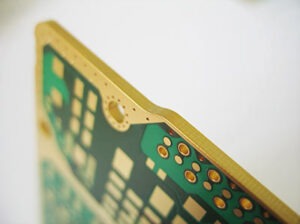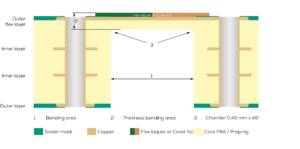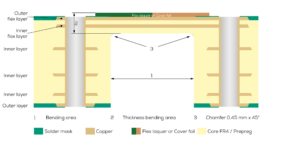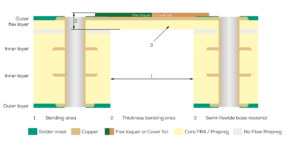With HSMtec® PCBs, high-current paths and fine conductor layout can be combined in one board by partially integrating copper profiles in the PCB. The diverse design variants allow the targeted routing of high currents and heat loss in PCBs.

This PCB technology is ideal for applications in which control and power electronics come together. Thanks to the partial integration of copper profiles into the PCB, high-current paths - or thermal management and fine conductor layout - can be easily combined and adapted to the spatial conditions. The diverse design variants allow high currents and heat loss from components to be routed into PCBs in a targeted manner - without any further external work steps.
In this PCB manufacturing process, copper profiles are embedded directly into the PCB and bonded to the etched inner and/or outer layers using patented ultrasonic bonding technology. This enables simple integration into a standard multilayer production process with subsequent pressing of the individual layers.
Copper elements with variable widths from 2 to 12 mm and individual lengths offer the greatest possible flexibility for the high-current layout and thermal design of the PCB. Even with existing PCB designs, performance can be significantly increased.

| Materials | FR4 |
| Technology | High current, thermal management and 3D PCB |
| PCB thickness | 0.8 mm - 3.2 mm |
| Number of layers | 2 – 10 |
| End copper | 35 - 105 µm |
| Ladder structures | Depending on the end copper according to Design Compass |
| Smallest drill diameter | 0.25 mm; 0.50 mm through copper profiles |
| Aspect Ratio | ≤ 1:8 |
| Release stop masks | Photosensitive solder resist systems, UV coating systems Screen printing Colors: Green, white, black matt |
| Surfaces |
|
| Bending angle | ≤ 90° |
The specified values represent the maximum power spectrum and may be limited in certain combinations.
Solder resist masks
Additional prints
Edge metallization
In order to improve the EMC protection of a circuit board, to create an electrical contact to the housing of the assembly or to meet increased cleanliness requirements, the front sides of the circuit board contour can be metallized.

Milled vias
It is possible to produce application-specific components with so-called milled through-holes. The resulting circuit boards can be soldered onto another circuit board as components (interposer) due to their front-side contacting option.

Contour processing
Contour production: milling and scoring
High currents directly integrated
High-current and fine conductor structures on a PCB are not a contradiction in terms - even within the same layer. By selectively inserting large copper cross-sections at any point on a standard multilayer, currents of up to 400 amps can be easily combined with the finest conductor structures on a PCB.
Copper profiles are embedded directly into the PCB and bonded to the etched inner and outer layers using patented ultrasonic bonding technology.

Increase reliability. Reduce interfaces.
High-current connections integrated directly into the circuit board eliminate the need for separate circuit boards for control electronics. This replaces external components such as busbars, connection elements, plugs and cables - resulting in significantly increased reliability of the entire assembly.

Asymmetrical with a copper layer in the flex area (depth-milled)

Asymmetrical with two copper layers in the flex area (depth-milled)

Asymmetrical with a copper layer in the flex area (SF technology)

The rapid dissipation of heat loss from modern power components ensures a long service life of the assembly and optimizes its efficiency. The partial integration of solid copper elements in FR4 printed circuit boards makes it possible to realize the lowest thermal resistance for every component size and shape and thus specifically avoid hotspots.
Targeted reduction of system costs
Costs for assembly, logistics, procurement and placement are an increasingly critical factor in the design of an assembly. The complete integration of high-current and control electronics in a single PCB significantly reduces overall system costs compared to conventional PCB technologies.

High performance in the smallest space
HSMtec® PCBs offer the option of bending individual PCB segments once by up to 90 degrees. Copper profiles integrated into the bending points ensure mechanical stability and allow signal, high-current and thermal connections to be implemented between individual PCB segments. This minimizes potential failure risks.

Between 3D integration and cost pressure - expert tips for cost-efficient 3D printed circuit boards
Are you faced with the challenge of assembling your electronics under difficult installation conditions and still have to adhere to tight budgets? Then three-dimensional PCBs could be your key to success. After all, these space-saving wonders are known for increasing packing density, reducing weight and system costs and increasing the reliability of the assembly. Look forward to a new issue of KSG XPERTS, in which Ralph Fiehler and Sebastian Seifert provide you with valuable tips and tricks for cost-efficient 3D PCBs.
In this online seminar


The smart platform for fast and reliable PCB development.
We have bundled all the parameters for you in our Design Compass.
The dimensioning of the conductor tracks is subject to a standard set of rules. You can therefore use our practical high-current calculator for your initial calculations. This tool offers you a quick and easy way to calculate the required conductor width for high-current conductors on a FR4 printed circuit board to calculate. Please enter the following values:
Gene, we will create a customized solution concept for your high-current application

Talk to us in the early development phases of your project and contact our team of experts. Together we will find the solution that will make your product even better.

With a workshop at our premises or at your site, we give you the opportunity to discuss the key technical aspects and features of your project in detail.

From design and layout checks to various calculations and thermal analyses - the experienced, competent Technical Support team will be happy to help you.